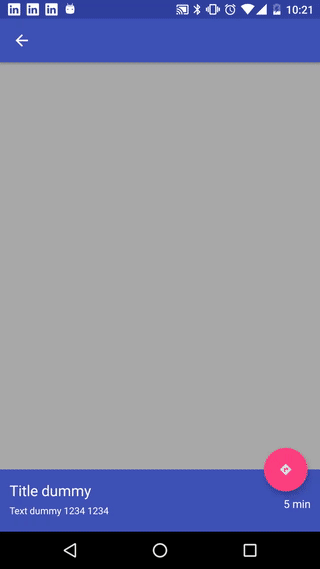像 Google 地圖一樣的 BottomSheetBehavior
Version >= 2.1.x
此示例取決於支援庫 23.4.0。+。
BottomSheetBehavior 的特點是:
- 兩個帶有動畫的工具欄,可響應底部的紙張移動。
- 當 FAB 靠近模態工具欄(當你向上滑動時出現的那個)時隱藏的 FAB。
- 底部背後的背景影象與某種視差效果。
- 工具欄中的標題(TextView)在底部工作表到達時顯示。
- 通知 satus 欄可以將其背景變為透明或全綵。
- 具有錨狀態的自定義底部表單行為。
現在讓我們逐一檢查它們:
工具欄
當你在谷歌地圖中開啟該檢視時,你可以看到一個工具欄,你可以在其中搜尋,這是我唯一一個與谷歌地圖完全不同的工具欄,因為我想更加通用。無論如何,ToolBar 在 AppBarLayout 中,當你開始拖動 BottomSheet 時它被隱藏,當 BottomSheet 到達 COLLAPSED 狀態時它再次出現。
要實現它,你需要:
- 建立一個
Behavior並從AppBarLayout.ScrollingViewBehavior擴充套件它 - 覆蓋
layoutDependsOn和onDependentViewChanged方法。這樣做你將聽取 bottomSheet 的動作。 - 建立一些方法來隱藏和取消隱藏帶有動畫的 AppBarLayout / ToolBar。
這是我為第一個工具欄或 ActionBar 做的方式:
@Override
public boolean layoutDependsOn(CoordinatorLayout parent, View child, View dependency) {
return dependency instanceof NestedScrollView;
}
@Override
public boolean onDependentViewChanged(CoordinatorLayout parent, View child,
View dependency) {
if (mChild == null) {
initValues(child, dependency);
return false;
}
float dVerticalScroll = dependency.getY() - mPreviousY;
mPreviousY = dependency.getY();
//going up
if (dVerticalScroll <= 0 && !hidden) {
dismissAppBar(child);
return true;
}
return false;
}
private void initValues(final View child, View dependency) {
mChild = child;
mInitialY = child.getY();
BottomSheetBehaviorGoogleMapsLike bottomSheetBehavior = BottomSheetBehaviorGoogleMapsLike.from(dependency);
bottomSheetBehavior.addBottomSheetCallback(new BottomSheetBehaviorGoogleMapsLike.BottomSheetCallback() {
@Override
public void onStateChanged(@NonNull View bottomSheet, @BottomSheetBehaviorGoogleMapsLike.State int newState) {
if (newState == BottomSheetBehaviorGoogleMapsLike.STATE_COLLAPSED ||
newState == BottomSheetBehaviorGoogleMapsLike.STATE_HIDDEN)
showAppBar(child);
}
@Override
public void onSlide(@NonNull View bottomSheet, float slideOffset) {
}
});
}
private void dismissAppBar(View child){
hidden = true;
AppBarLayout appBarLayout = (AppBarLayout)child;
mToolbarAnimation = appBarLayout.animate().setDuration(mContext.getResources().getInteger(android.R.integer.config_shortAnimTime));
mToolbarAnimation.y(-(mChild.getHeight()+25)).start();
}
private void showAppBar(View child) {
hidden = false;
AppBarLayout appBarLayout = (AppBarLayout)child;
mToolbarAnimation = appBarLayout.animate().setDuration(mContext.getResources().getInteger(android.R.integer.config_mediumAnimTime));
mToolbarAnimation.y(mInitialY).start();
}
第二個工具欄或模態工具欄:
你必須覆蓋相同的方法,但在這個方法中你必須處理更多行為:
- 用動畫顯示/隱藏工具欄
- 更改狀態列顏色/背景
- 在 ToolBar 中顯示/隱藏 BottomSheet 標題
- 關閉 bottomSheet 或將其傳送到摺疊狀態
這個的程式碼有點廣泛,所以我會讓連結
FAB
這也是一種自定義行為,但是從 FloatingActionButton.Behavior 延伸出來。在 onDependentViewChanged 中,你必須看到它到達 offSet 或你要隱藏它的位置。在我的情況下,當它靠近第二個工具欄時我想要隱藏它,所以我深入研究 FAB 父(CoordinatorLayout)尋找包含 ToolBar 的 AppBarLayout,然後我使用像 OffSet 這樣的 ToolBar 位置:
@Override
public boolean onDependentViewChanged(CoordinatorLayout parent, FloatingActionButton child, View dependency) {
if (offset == 0)
setOffsetValue(parent);
if (dependency.getY() <=0)
return false;
if (child.getY() <= (offset + child.getHeight()) && child.getVisibility() == View.VISIBLE)
child.hide();
else if (child.getY() > offset && child.getVisibility() != View.VISIBLE)
child.show();
return false;
}
具有視差效果的 BottomSheet 背後的影象 :
與其他影象一樣,它是一種自定義行為,這一項中唯一複雜的東西是保持影象錨定到 BottomSheet 的小演算法,並避免影象崩潰,如預設視差效果:
@Override
public boolean onDependentViewChanged(CoordinatorLayout parent, View child,
View dependency) {
if (mYmultiplier == 0) {
initValues(child, dependency);
return true;
}
float dVerticalScroll = dependency.getY() - mPreviousY;
mPreviousY = dependency.getY();
//going up
if (dVerticalScroll <= 0 && child.getY() <= 0) {
child.setY(0);
return true;
}
//going down
if (dVerticalScroll >= 0 && dependency.getY() <= mImageHeight)
return false;
child.setY( (int)(child.getY() + (dVerticalScroll * mYmultiplier) ) );
return true;
}
現在結束: 自定義 BottomSheet 行為
要實現 3 個步驟,首先你需要了解預設 BottomSheetBehavior 有 5 個狀態:STATE_DRAGGING, STATE_SETTLING, STATE_EXPANDED, STATE_COLLAPSED, STATE_HIDDEN 和 Google Maps 行為,你需要在摺疊和展開之間新增中間狀態:STATE_ANCHOR_POINT。
我試圖擴充套件預設的 bottomSheetBehavior 沒有成功,所以我只是複製貼上所有程式碼並修改我需要的東西。
要實現我正在談論的內容,請按照以下步驟操作:
-
建立一個 Java 類並從
CoordinatorLayout.Behavior<V>擴充套件它 -
將預設
BottomSheetBehavior檔案中的貼上程式碼複製到新檔案中。 -
使用以下程式碼修改方法
clampViewPositionVertical:@Override public int clampViewPositionVertical(View child, int top, int dy) { return constrain(top, mMinOffset, mHideable ? mParentHeight : mMaxOffset); } int constrain(int amount, int low, int high) { return amount < low ? low : (amount > high ? high : amount); } -
新增新狀態
public static final int STATE_ANCHOR_POINT = X;
-
修改下一個方法:
onLayoutChild,onStopNestedScroll,BottomSheetBehavior<V> from(V view)和setState(可選)
public boolean onLayoutChild(CoordinatorLayout parent, V child, int layoutDirection) {
// First let the parent lay it out
if (mState != STATE_DRAGGING && mState != STATE_SETTLING) {
if (ViewCompat.getFitsSystemWindows(parent) &&
!ViewCompat.getFitsSystemWindows(child)) {
ViewCompat.setFitsSystemWindows(child, true);
}
parent.onLayoutChild(child, layoutDirection);
}
// Offset the bottom sheet
mParentHeight = parent.getHeight();
mMinOffset = Math.max(0, mParentHeight - child.getHeight());
mMaxOffset = Math.max(mParentHeight - mPeekHeight, mMinOffset);
//if (mState == STATE_EXPANDED) {
// ViewCompat.offsetTopAndBottom(child, mMinOffset);
//} else if (mHideable && mState == STATE_HIDDEN...
if (mState == STATE_ANCHOR_POINT) {
ViewCompat.offsetTopAndBottom(child, mAnchorPoint);
} else if (mState == STATE_EXPANDED) {
ViewCompat.offsetTopAndBottom(child, mMinOffset);
} else if (mHideable && mState == STATE_HIDDEN) {
ViewCompat.offsetTopAndBottom(child, mParentHeight);
} else if (mState == STATE_COLLAPSED) {
ViewCompat.offsetTopAndBottom(child, mMaxOffset);
}
if (mViewDragHelper == null) {
mViewDragHelper = ViewDragHelper.create(parent, mDragCallback);
}
mViewRef = new WeakReference<>(child);
mNestedScrollingChildRef = new WeakReference<>(findScrollingChild(child));
return true;
}
public void onStopNestedScroll(CoordinatorLayout coordinatorLayout, V child, View target) {
if (child.getTop() == mMinOffset) {
setStateInternal(STATE_EXPANDED);
return;
}
if (target != mNestedScrollingChildRef.get() || !mNestedScrolled) {
return;
}
int top;
int targetState;
if (mLastNestedScrollDy > 0) {
//top = mMinOffset;
//targetState = STATE_EXPANDED;
int currentTop = child.getTop();
if (currentTop > mAnchorPoint) {
top = mAnchorPoint;
targetState = STATE_ANCHOR_POINT;
}
else {
top = mMinOffset;
targetState = STATE_EXPANDED;
}
} else if (mHideable && shouldHide(child, getYVelocity())) {
top = mParentHeight;
targetState = STATE_HIDDEN;
} else if (mLastNestedScrollDy == 0) {
int currentTop = child.getTop();
if (Math.abs(currentTop - mMinOffset) < Math.abs(currentTop - mMaxOffset)) {
top = mMinOffset;
targetState = STATE_EXPANDED;
} else {
top = mMaxOffset;
targetState = STATE_COLLAPSED;
}
} else {
//top = mMaxOffset;
//targetState = STATE_COLLAPSED;
int currentTop = child.getTop();
if (currentTop > mAnchorPoint) {
top = mMaxOffset;
targetState = STATE_COLLAPSED;
}
else {
top = mAnchorPoint;
targetState = STATE_ANCHOR_POINT;
}
}
if (mViewDragHelper.smoothSlideViewTo(child, child.getLeft(), top)) {
setStateInternal(STATE_SETTLING);
ViewCompat.postOnAnimation(child, new SettleRunnable(child, targetState));
} else {
setStateInternal(targetState);
}
mNestedScrolled = false;
}
public final void setState(@State int state) {
if (state == mState) {
return;
}
if (mViewRef == null) {
// The view is not laid out yet; modify mState and let onLayoutChild handle it later
/**
* New behavior (added: state == STATE_ANCHOR_POINT ||)
*/
if (state == STATE_COLLAPSED || state == STATE_EXPANDED ||
state == STATE_ANCHOR_POINT ||
(mHideable && state == STATE_HIDDEN)) {
mState = state;
}
return;
}
V child = mViewRef.get();
if (child == null) {
return;
}
int top;
if (state == STATE_COLLAPSED) {
top = mMaxOffset;
} else if (state == STATE_ANCHOR_POINT) {
top = mAnchorPoint;
} else if (state == STATE_EXPANDED) {
top = mMinOffset;
} else if (mHideable && state == STATE_HIDDEN) {
top = mParentHeight;
} else {
throw new IllegalArgumentException("Illegal state argument: " + state);
}
setStateInternal(STATE_SETTLING);
if (mViewDragHelper.smoothSlideViewTo(child, child.getLeft(), top)) {
ViewCompat.postOnAnimation(child, new SettleRunnable(child, state));
}
}
public static <V extends View> BottomSheetBehaviorGoogleMapsLike<V> from(V view) {
ViewGroup.LayoutParams params = view.getLayoutParams();
if (!(params instanceof CoordinatorLayout.LayoutParams)) {
throw new IllegalArgumentException("The view is not a child of CoordinatorLayout");
}
CoordinatorLayout.Behavior behavior = ((CoordinatorLayout.LayoutParams) params)
.getBehavior();
if (!(behavior instanceof BottomSheetBehaviorGoogleMapsLike)) {
throw new IllegalArgumentException(
"The view is not associated with BottomSheetBehaviorGoogleMapsLike");
}
return (BottomSheetBehaviorGoogleMapsLike<V>) behavior;
}
連結到整個專案 ,你可以在其中檢視所有自定義行為
這就是它的樣子:
[  ]
]